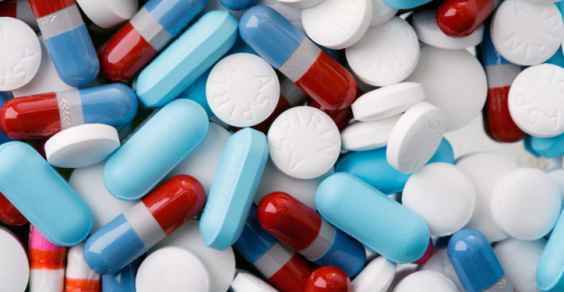Very often the drugs we take have more risks to our health than they do. Every year, the French magazine 'Prescgere' publishes a report, in which it lists a number of medicines that can be replaced by better and less harmful alternatives.
Don't store avocado like this: it's dangerousVery often the drugs we take have more risks to our health than benefits. Every year, the French magazine 'Prescribe' publishes a report, listing a range of medicines that can be replaced by better and less harmful alternatives.
According to the 2017 report, the marketing of drugs, but there is often no previous evidence of their effectiveness and what the intake entails. “Sometimes - we read - they are less effective or even harmful, yet they continue to enjoy an excellent reputation among health workers and patients ".
Now, therefore, comes the new blacklist of drugs, 91 in all, in which the relationship between risk and benefit is unfavorable in all clinical situations. We are talking about products sold throughout the European Union which are analyzed in order to study their effects negative, positive and their real effectiveness.
“Prescteggio's assessment of a drug's risk-benefit ratio in a given situation is based on a strict process: systematic and reproducible desk research, determination of efficacy criteria for patients, hierarchy of scientific data based on their level of evidence, comparison with standard treatment, consideration of adverse effects and their share of unknowns ", reads the abstract of the Report.
READ also: SIDE EFFECTS OF DRUGS: KNOWING ALTERNATIVE MEDICINE TO DETOXIFY THE ORGANISM
Too many risks, few positive effects
Five years after the first publication, drugs are no longer only those marketed in France but throughout the European Union.
“Most of the time, when one pharmacological therapy it is desirable, other options have a better risk-benefit ratio than that of discarded drugs. In a therapeutic deadlock, for serious illnesses, it is not justified to expose patients to serious risks when clinical efficacy is not demonstrated, ”it reads.
And yet:
“The use of these drugs during a clinical research it may be acceptable, but on the condition that patients are informed of the unknowns about the benefit-risk balance and that an evaluation is useful. In other cases, it is best to focus on treatments to help patients tolerate the absence of options to change prognosis or improve life quality, beyond the placebo effect ".
Among the 91 drugs, ranging from treatment against the cold with decongestants, you are exposed to serious or even fatal cardiovascular risks. In the leaflet, we talk about hypertension, stroke, heart rhythm disturbances.
READ also: DRUGS: HOW TO KEEP THEM WITH WARM. THE AIFA DECALOGUE

A long rundown, let's see some of them. With the antiinflammatory (Cox 2 inhibitors) increased cardiovascular accidents (including myocardial infarction and thrombosis) and typical skin reactions have been correlated; medications for cramps they can cause diarrhea, stomach pain, photodermatitis and seizures. Because they are genotoxic and teratogenic, they harm the fetus and can cause it miscarriage.
In terms of drugs against weight gain, Xenical has only modest and temporary efficacy. “As of 2017, no drug can sustainably and safely lose weight. Better to stick with physical activity and diet changes with psychological support if needed.
Different treatments against osteoporosis should be excluded, for example strontium ranelate (Protelos), which can cause neurological and cardiovascular disorders.
READ also: PAIN RELIEF: NON-STEROID DRUGS HARM THE HEART
Blacklist of drugs that do more harm than good
Oncology, hematology: mifamurtide, nintedanib, olaparib, panobinostat, rabectedina, vandetanib, vinflunina, catumaxomab, defibrotide.
Cardiology: aliskirene, bezafibrato, ciprofibrato, fenofibrato, dronedarone, ivabradina, nicorandil, olmesartan, ranolazina, trimetazidina, vernakalant.
Dermatology, allergology: mechitazine, omalizumab, promethazine iniettabile, tacrolimus.
Diabetes, nutrition: alogliptin, linagliptin, saxagliptin, sitagliptin, vildagliptin, canagliflozin, dapagliflozin, pioglitazone, bupropion + naltrexone, orlistat.
Pain, rheumatology: celecoxib, etoricoxib, parecoxib, aceclofenac, diclofenac, ketoprofen in gel, piroxicam, denosumab, strontium ranelate, diaceréin, glucosamine, capsaicin in patch, metocarbamol, thiocolchicoside, quinine, colchicine + salmonetone + salamylate hydroxyethyl, prednisolone + dipropylene glycol salicylate.
Gastroenterology: domperidone, droperidol, prucalopride.
Gynecology, endocrinology: tibolone.
Infectious diseases: moxifloxacina, telitromicina.
Neurology: donepezil, galantamina, rivastigmina, memantina, alemtuzumab, natalizumab, teriflunomide, flunarizina, oxetorone, tolcapone.
Ophthalmology: cyclosporine in eye drops, idebenone.
Pulmonology, ENT: ephedrine, naphazoline, oximetazoline, phenylephrine, pseudoephedrine, tuaminoheptane, ambroxol, bromhexine, folcodein, thixocortol, omalizumab, mepolizumab, mannitol for inhalation, nintedanib.
Psychiatry, addictions: agomelatina, duloxetina, citalopram, escitalopram, milnacipran, venlafaxina, tianeptina, dapoxetina, etifoxina, bupropione.
To view the list of medications with all health details click here
Dominella Trunfio
Source: Prescribe


























